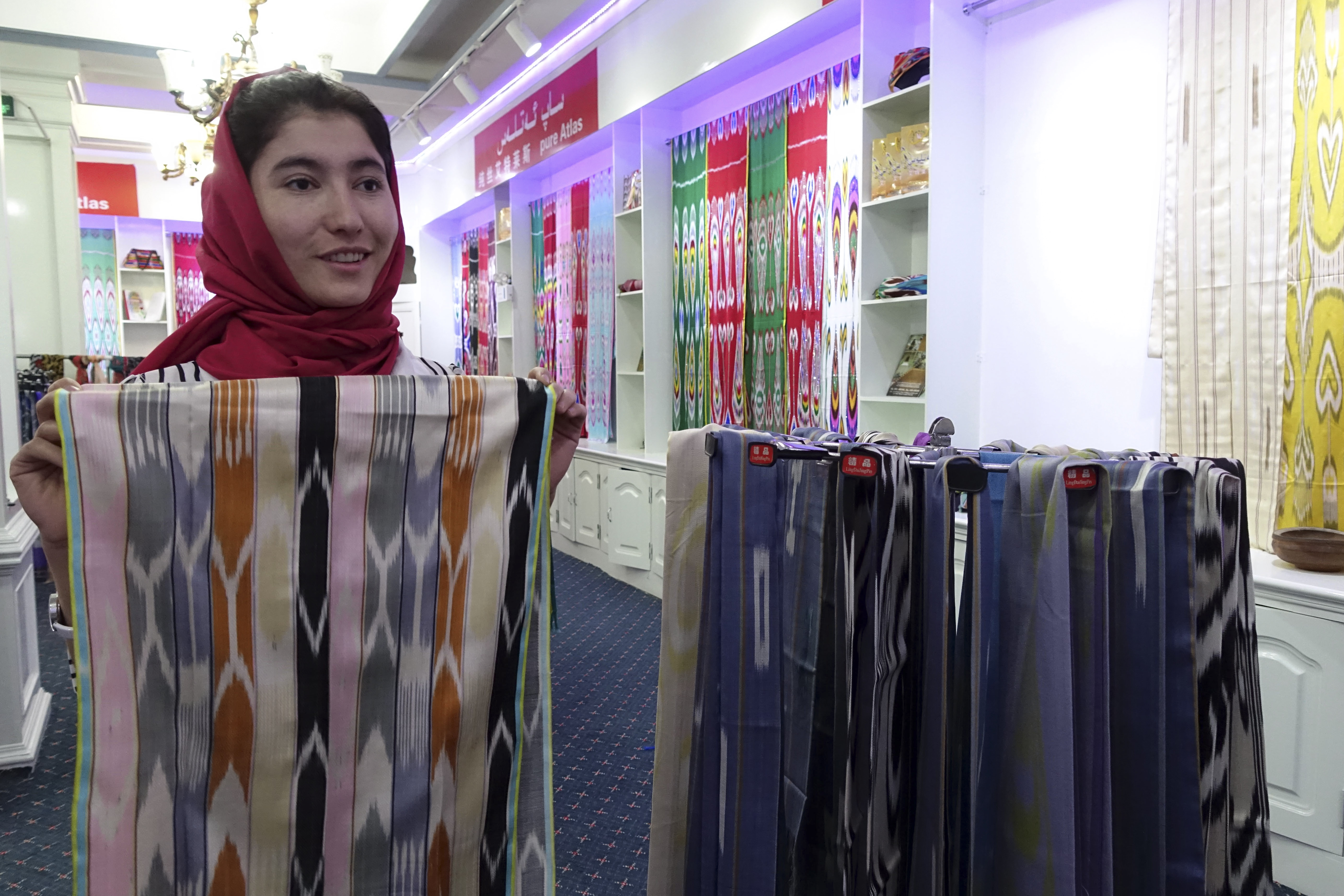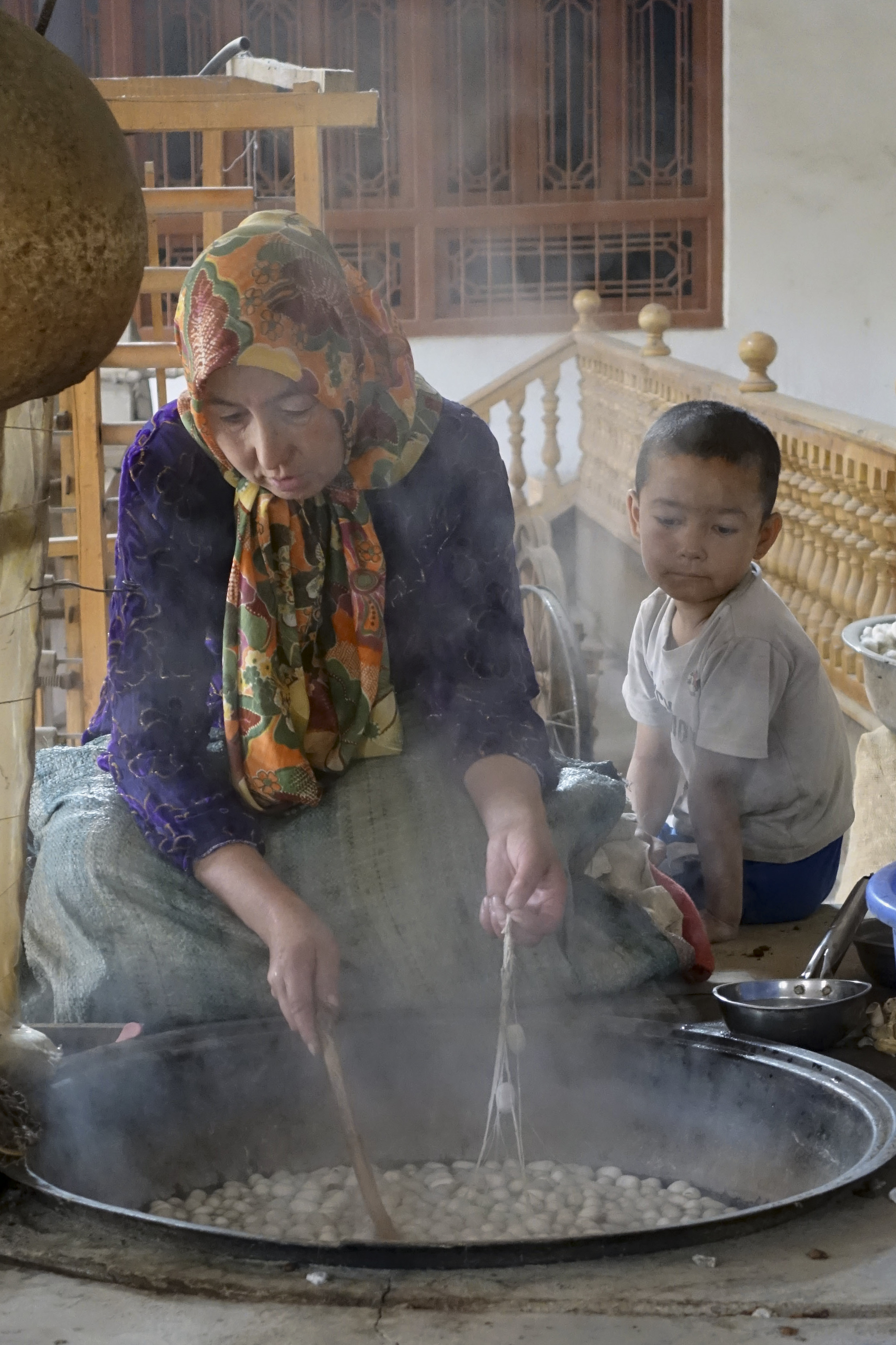
Buzurem Meturoz shows a piece of etles to visitors. The 23-year-old has been learning to color etles in the small factory for four years.[Photo by Wang Zhuangfei/China Daily]
Every morning Ausman Tarim, 72, walks to a tiny factory near his home to put his wrinkled hands to work. There he does what he has been doing for the past 58 years: weaving etles, traditional Uygur silk that in a bygone age was among the most popular items on the Silk Road and which has become a symbol of the Uygur people.
Tarim and countless other villagers in Jiya, Hotan prefecture, Xinjiang Uygur autonomous region, have been making etles for more than 2,000 years and are determined to ensure that their fine skills will still exist in another 2,000 years.
“Little has changed,” Ausman says, sitting at the end of a wooden loom six and a half meters’ long. “We still use the same techniques and natural dyes, so what you see now is exactly what would have been sold on the ancient Silk Road.”
Yarns consisting of tie-dyed black and white silk (the tie-dyed refers to the process in which fabric is bound before it is dyed, resulting in a variegated pattern) is woven on the machine longitudinally, and Ausman’s job is to use lateral silk yarns to produce a piece of cloth.
Ausman says his craftsmanship is something his father passed on to him.
“It’s a family tradition and a very delicate job that deserves full concentration. My father said the smart ones can master weaving etles in less than two years, but with the dumbies it may take more than three years.”
He adds, laughing: “I’m the dumb one.”

Ausman Tarim, 72, starts his routine work every morning in a factory near his home in Hotan, Xinjiang Uygur autonomous region. He has been weaving traditional Uygur silk for 58 years.[Photo by Wang Zhuangfei/China Daily]
Etles is a Uygur word that means tie-died. In the wardrobes of Uygur women, dresses made of etles with unique patterns and bold color combinations are a must. When people think about Uygurs, the image of a beautiful young girl with long braided hair in an etles silk dress and a dopa, a traditional four-pointed flat hat, may well spring to mind.
For Ausman, the most difficult part of weaving etles is to locate the broken thin silk threads and piece them back together with a tiny knot that needs to be almost imperceptible.
“I am getting old now,” he says, trying to locate a broken thread. “My eyes have become blurry and my hands are shaky so I cannot weave as fast as I used to but I don’t want to stop because it feels like I’m creating something with lives instead of pieces of silk.”
Of all the processes in etles making, weaving is in fact the easiest part, Ausman says. The most difficult and crucial job is to tied-dye the silk and arrange the colored silk for the weavers.
Certain parts of the pure white silk will be clamped tightly together with circles of thick white cotton threads. The parts covered by cotton threads will have no contact with the dye so they will not be colored. During the process some dye will seep into the silk through the edges of the cotton threads to randomly form smudges, which make every piece of etles unique and which has become the distinguishing feature of the traditional Uygur handcraft.
The masters of tie-dyeing are the most respected people in Jiya. The techniques they use are a closely guarded secret. In the workshop, all eltes are tied-dyed with natural colorings extracted from plants accessible by the villagers, who live on the edge of the Taklimakan, the world’s second largest desert.
“We use twigs of rose willows that grow in the dessert near us to create the orange color and the skin of fresh walnuts coming from our backyards to dye the silk green,” says Buzurem Meturoz, 23, who has been learning to color etles in the small factory for four years. In that time she has gone about the arduous task of becoming acquainted with how to use more than 30 natural colors and to engage her imagination in dyeing and designing etles.
Each etles can have seven to eight different colors, and sometimes it only has two. “There are no rules or boundaries,” Buzurem says. “Sometimes we just experiment.”
Chemical dyes will impart etles with very bold colors, while any dyed with natural colors will have a softer look.

A Uygur woman processes silkworm cocoons, the raw material for weaving, at home.[Photo by Wang Zhungfei/China Daily]
Jiya was once a part of an ancient kingdom called Yutian, a center of trade on the ancient Silk Road and one of the biggest kingdoms among the 36 kingdoms in Xinjiang first recorded during the Western Han Dynasty (206 BC-AD 24). Records show that the Yutian kings brought large quantities of silk to Central China to trade, and they were very popular.
These days Jiyans have to bring in silkworm cocoons from southern China from which to reel off raw silk because they have cut down the mulberry trees to plant date trees or walnut trees, which are more profitable.
However, the inhabitants are able to cream off extra income by making etles. While the masters make them by hand, most villagers use electric looms.
A bolt of hand-made etles costs 300 yuan ($47), more expensive than those made by machines, says Tajilisa Metson, 21, who has been learning how to make etles for five years.
“More and more people are willing to pay a higher price for hand-made ones because they see them as works of art.”
All of her family make etles, she says.
“It’s a family tradition, and it’s as though we are born to do it.”
The small factory in which Ausman works belongs to Jiya Beauty Company, the biggest etles company in Hotan, whose annual turnover is about 5 million yuan ($780,000), says Rozmemet Metudi, the manager.
“More than 90 percent of what we make is sold outside Xinjiang, and some is exported overseas. It’s most popular in Uzbekistan, our neighbor.”
On Aug 24, the company says, it received 500,000 yuan in government funding to be used to give the traditional designs a modern twist so etles can be promoted on the world stage and bring more income to the villagers, who will also receive training so they can become creative designers too.
Some Chinese fashion designers have incorporated etles elements into their works that they have shown around the world. Etles patterns have also been printed on mugs, cushions and even running shoes.
Amar Ali, 61, an etles master in Jiya, has just returned from Shanghai after promoting the craft there.
“People in Shanghai people loved it,” says Amar, who has been in the trade for 45 years.
“They were fascinated about how the etles is made. I really wish I had been able to take my wooden loom with me. Etles is very old, but with modern designs it can be made to appeal to the young and be very popular with modern designs.
“We Jiyans plan to keep it alive forever by sticking to tradition but also exploring the new.”
Plans are afoot to open an online etles shop, he says, and he has suggested that it include a video showing the operations of an etles factory.
“I’m confident that with our beautiful etles no one will be able to resist.”
Mao Weihua and Yang Wanli contributed to the story.
